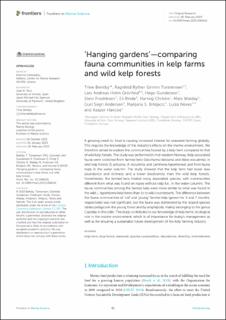| dc.contributor.author | Bekkby, Trine | |
| dc.contributor.author | Torstensen, Ragnhild Ryther Grimm | |
| dc.contributor.author | Grünfeld, Lars Andreas Holm | |
| dc.contributor.author | Gundersen, Hege | |
| dc.contributor.author | Fredriksen, Stein | |
| dc.contributor.author | Rinde, Eli | |
| dc.contributor.author | Christie, Hartvig C | |
| dc.contributor.author | Walday, Mats Gunnar | |
| dc.contributor.author | Andersen, Guri Sogn | |
| dc.contributor.author | Brkljacic, Marijana Stenrud | |
| dc.contributor.author | Neves, Luiza S. | |
| dc.contributor.author | Hancke, Kasper | |
| dc.date.accessioned | 2023-02-21T12:37:41Z | |
| dc.date.available | 2023-02-21T12:37:41Z | |
| dc.date.created | 2023-01-31T10:23:01Z | |
| dc.date.issued | 2023 | |
| dc.identifier.citation | Frontiers in Marine Science. 2023, 10 . | |
| dc.identifier.issn | 2296-7745 | |
| dc.identifier.uri | https://hdl.handle.net/11250/3052752 | |
| dc.description.abstract | A growing need for food is causing increased interest for seaweed farming globally. This requires knowledge of the industry’s effects on the marine environment. We therefore aimed to explore the communities hosted by a kelp farm compared to that of wild kelp forests. The study was performed in mid-western Norway. Kelp associated fauna were collected from farmed kelp (Saccharina latissima and Alaria esculenta), in wild kelp forests (S. latissima, A. esculenta and Laminaria hyperborea), and from fauna traps in the water column. The study showed that the kelp farm had lower taxa abundance and richness and a lower biodiversity than the wild kelp forests. Nonetheless, the farmed kelp hosted many associated species, with communities different from what was found on ropes without kelp (i.e., in the water column). The fauna communities among the farmed kelp were more similar to what was found in the wild L. hyperborea kelp forest than to its wild counterparts. The difference between the fauna communities of ‘old’ and ‘young’ farmed kelp (grown for 3 and 7 months, respectively) was not significant, but the fauna was dominated by the isopod species Idotea pelagica in the young forest and by amphipods, mainly belonging to the genus Caprella, in the older. The study contributes to our knowledge of kelp farms’ ecological role in the marine environment, which is of importance for today’s management as well as for ensuring a sustainable future development of the kelp farming industry. | |
| dc.description.abstract | "Hanging gardens" - comparing fauna communities in kelp farms and wild kelp forests | |
| dc.language.iso | eng | |
| dc.relation.uri | https://www.frontiersin.org/articles/10.3389/fmars.2023.1066101/full | |
| dc.subject | Marin økologi | |
| dc.subject | Marine ecology | |
| dc.title | "Hanging gardens" - comparing fauna communities in kelp farms and wild kelp forests | |
| dc.title.alternative | "Hanging gardens" - comparing fauna communities in kelp farms and wild kelp forests | |
| dc.type | Peer reviewed | |
| dc.type | Journal article | |
| dc.description.version | publishedVersion | |
| dc.subject.nsi | VDP::Basale biofag: 470 | |
| dc.subject.nsi | VDP::Basic biosciences: 470 | |
| dc.source.pagenumber | 10 | |
| dc.source.volume | 10 | |
| dc.source.journal | Frontiers in Marine Science | |
| dc.identifier.doi | https://doi.org/10.3389/fmars.2023.1066101 | |
| dc.identifier.cristin | 2119534 | |
| dc.relation.project | Norges forskningsråd: 267536 | |
| cristin.ispublished | false | |
| cristin.fulltext | original | |
| cristin.qualitycode | 1 | |
